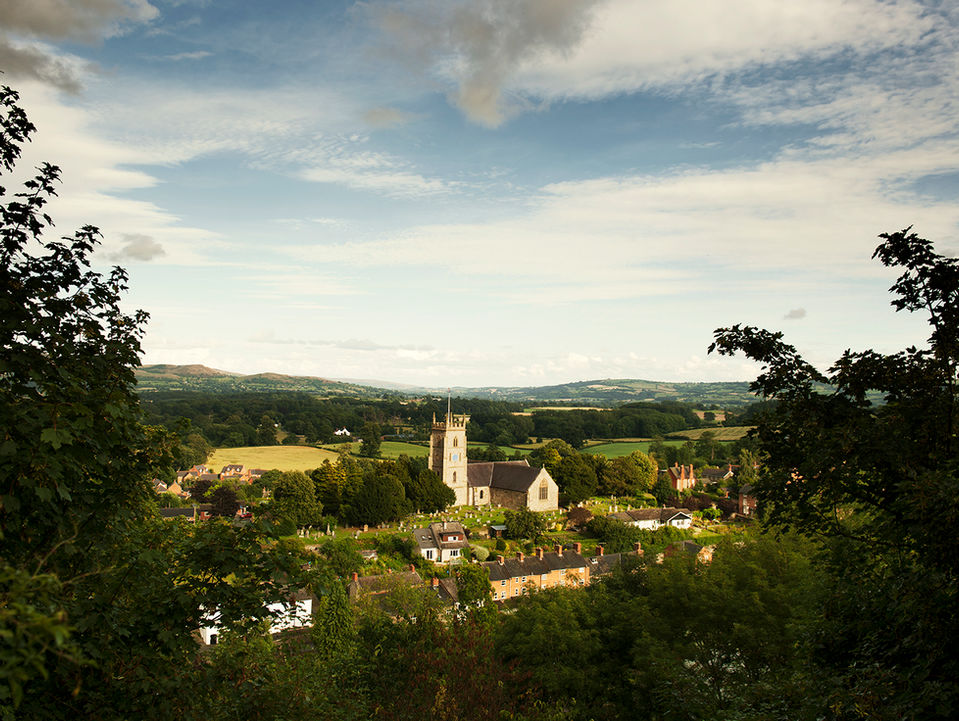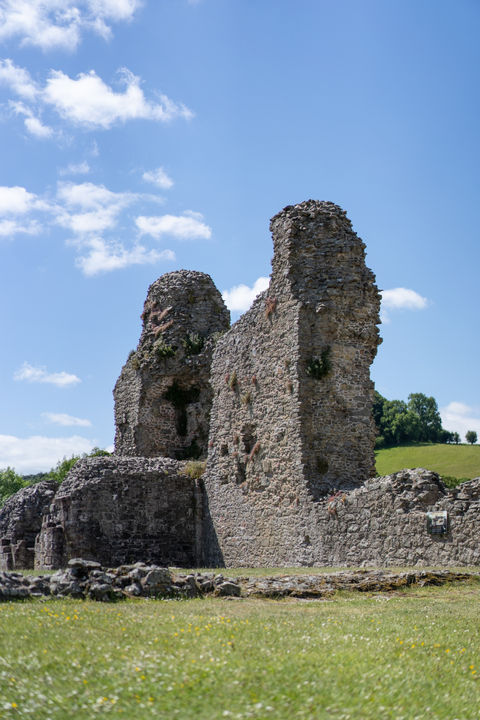
Montgomery
With a street plan that has remained largely unchanged for over eight centuries, handsome Victorian and Georgian architecture and a ruined medieval castle perched above it, Montgomery is a place that wears its heritage proudly. But this market town, close to the border with England, is also a thriving 21st-century community with plenty to offer. These historic streets are now home to a tempting selection of shops, cafés and restaurants – plus a lively, year-round programme of markets, festivals and cultural events.
Tucked in beneath the rugged, stony outcrop that’s home to the town’s medieval castle (more on that later), Montgomery has a grandeur that outstrips its comparatively small size, a reflection of its former status as the county town of Montgomeryshire. The central (and aptly named) Broad Street makes a striking first impression – a wide, elegant thoroughfare lined with handsome Georgian townhouses and bookended by the red brick Town Hall, built in 1738.
Alongside buildings from this period, you’ll also find Victorian architecture and half-timbered houses from Montgomery’s earlier history. As you explore, keep your eyes peeled for the grey plaques attached to walls and buildings, each one revealing historical titbits from the town’s long and storied past.
Market forces
Despite its justifiable pride in its heritage, Montgomery remains very much a going concern. The weekly Thursday market (another historic asset, held since the town was granted a charter in 1227) attracts tradespeople and shoppers from across the area, while many of the town’s ancient buildings are now home to businesses selling everything from books to bouquets of flowers.
There’s also a lively cultural calendar featuring events like the Monty Lit Fest, which sees writers from Wales and beyond descend on the town for a series of talks and workshops, and open-air performances of Shakespeare in the grounds of the castle.
What’s in store?
Montgomery’s streets are packed with shops, cafés, restaurants and delis, but perhaps its most celebrated store is Bunners on Arthur Street. Though it bills itself as an ironmongers, the term doesn’t really do justice to this Aladdin’s cave of a shop.
Still run by the same family that established it in 1892, it’s a higgledy-piggledy treasure trove with a dizzying array of products on sale. Whether you’re in the market for a quad bike, ride-on lawnmower, wood-burning stove or range cooker, or you just need to pick up crockery, kitchenware or seed potatoes for the garden, Bunners has you covered. You can even fill up with petrol or diesel from the authentically retro pumps flanking the shopfront.
Vantage point
The dramatic ruins of 13th-century Montgomery Castle sit on rocky crag above town – a strategic spot selected by Henry III’s adviser Hubert de Burgh. You don’t need to be a military genius to see why this was the perfect location for a castle. Surrounded on three sides by a naturally impregnable landscape of rugged cliffs and valleys, with views extending for miles in every direction, it’s little wonder that it endured repeated attacks from Welsh forces throughout the 13th century.
In fact, it managed to hold its ground until 1649, when it was eventually destroyed by Parliamentarians during the Civil War. It’s reached via a narrow lane the locals call the Conduit – originally designed as a last-ditch escape route from town to the safety of the castle.
People’s history
Located inside a former inn dating from the 16th century, The Old Bell Museum is a fascinating repository of local history. Run by a team of volunteers from the Montgomery Civic Society, it’s a well-loved community resource that links the town’s past and present.
Head inside and you’ll find items collected from Montgomery homes and businesses spanning centuries of local life, including antique maps, blacksmiths’ tools, photographs and artefacts discovered during the excavation of Montgomery Castle. There’s also a recreation of Hen Domen, Montgomery’s first castle. Built just north of the present-day town, this timber fortress, constructed in the 11th century, is one of the most extensively excavated castles of its period in the UK.
Rolling back the years
Largely dating from the 13th century, St Nicholas Church on Church Bank is also home to a time-travelling selection of features from different periods in its history.
The church tower was built in the 19th century, while the ornate canopied tomb of local lord (and holder of Montgomery Castle) Richard Herbert was crafted in the 16th century. The double chancel screen has its origins in the 15th century, while the beautifully carved wooden rood screen dates all the way back to the church’s origins in the 13th century.

CURIOSITIES AND SURPRISES
-
Crime and punishment. The graveyard of St Nicholas Church is home to memorials to two men called Davies who found themselves on opposite sides of the law. First, there’s the marble tombstone of PC William Davies (a local policeman who died in 1903 after collapsing while chasing sheep rustlers) decorated with carvings of a truncheon, lantern and police helmet. Not far away, you’ll find the Robber’s Grave, final resting place of John Davies of Wrexham, executed in 1821 for highway robbery. Davies protested his innocence until the end. According to legend, no grass grew on his grave for over 100 years as a result of this miscarriage of justice.
-
-
Listen up. If you hear a loud voice and a ringing bell echoing through the streets of Montgomery, it’s probably just the town crier. Originally a deliverer of news in days before newspapers, TV or the internet, this ancient role is alive and well here. You’ll often see the brightly dressed crier going about their business at local events (though you’ll probably hear them first). Keep an ear out for the distinctive cry of ‘Oyez!’ which precedes every proclamation.
-
-
That’s about the size of it. Take a good look at the houses along Broad Street and you might notice something unusual. Nearly all of them measure the same width (roughly 33ft/10m). This was the standard measurement of a burgess (or burgage) plot, a unit used by 13th-century town planners to mark out property boundaries.
-
-
Play on. The dramatic ruins of Montgomery Castle, high on a jagged cliffside above the town, is put to excellent use by annual open-air performances of Shakespearean theatre. Over the years, this former site of battle has been a venue for somewhat less bloody spectacles, including productions of A Midsummer Night’s Dream, The Tempest and Much Ado About Nothing.
-
-
Locked up. It’s hard to imagine now, but peaceful Montgomery was a place of punishment during the Victorian period. The imposing gateway of Montgomery’s former County Gaol, where prisoners would be subject to harsh regime of hard labour, can be seen in the north of the town. Built in the 19th century to replace the town’s Old Gaol, it’s now the striking entrance to a private home.



A DAY IN THE LIFE
To help you get the best out of your visit to Montgomery, we’ve outlined a few of the things you won’t want to miss. We’ve laid things out in a way that makes sense geographically, but feel free to tackle our suggestions in whatever order you see fit. And if you’re only in town for a short time, just take your pick from the places that interest you most.
Broad Street
Begin your visit at Montgomery’s attractive and spacious central strip. With the 18th-century red brick Town Hall at one end and elegant Georgian houses lining both of its sides, a stroll along here can feel like wandering into the pages of a Jane Austen novel. As you go, watch out for the grey plaques that reveal fascinating insights into Montgomery’s long history.
St Nicholas Church
Montgomery’s 13th-century church has stories to tell both inside and out. Head indoors to see the stunning hammer-beam roof, ornately carved medieval rood screen and striking 16th-century canopied tomb of local lord Richard Herbert.
Out in the churchyard you’ll find the Robber’s Grave, final resting place of a man hanged in 1821 for a crime he claimed he did not commit. According to local legend, a great storm blew in at the moment of his execution and no grass grew over his grave for 100 years because of the injustice he suffered.
Bunners
There are plenty of wonderful shops to browse throughout Montgomery, but Bunners is definitely one of the highlights. A wonderfully old-school rabbit warren of a store, run by the same family for over a century, stepping inside feels like travelling back in time. You can pick up just about anything in its maze of interconnected rooms, from house plants and electrical items to farming supplies and wood-burning stoves.
The Old Bell Museum
Once an inn and now a fascinating, community-run repository of local history, The Old Bell Museum lifts the lid on centuries of Montgomery life. It’s packed with an immersive collection of artefacts that cover every aspect of the town’s rich heritage. You’ll see antique items from the shelves of a Victorian pharmacy, tools used in the old blacksmiths’ workshop and discoveries unearthed in the excavation of medieval Montgomery Castle.
Montgomery Castle
Make the ascent up to the rocky crag overlooking town, either on foot via the steep lane known as The Conduit or by driving to the accessible car park, and explore the atmospheric ruins of Montgomery’s medieval fortress.
Built by Henry III to watch over a vital crossing of the River Severn, its lofty position offers long-range views that are as stunning today as they were strategically useful to the castle’s original occupants. Blending its walls and towers with the impassable cliffs and valleys around them, this castle proved extremely difficult to dislodge, remaining in use until the 17th century.




























